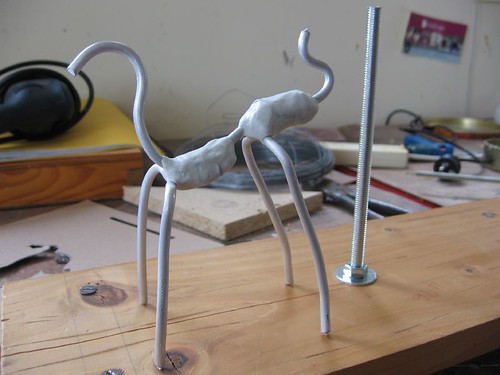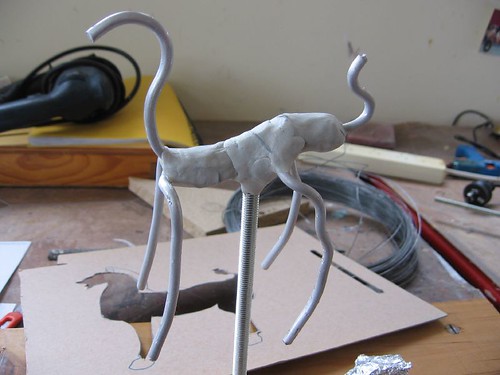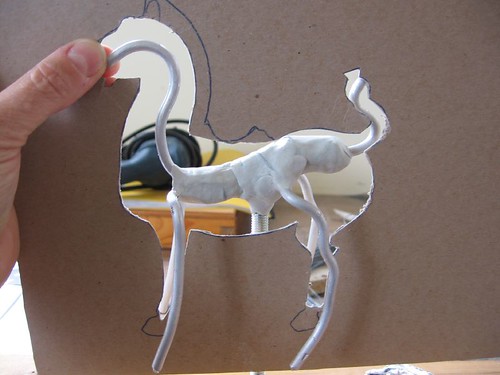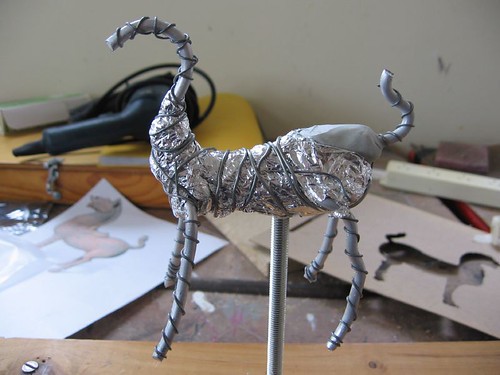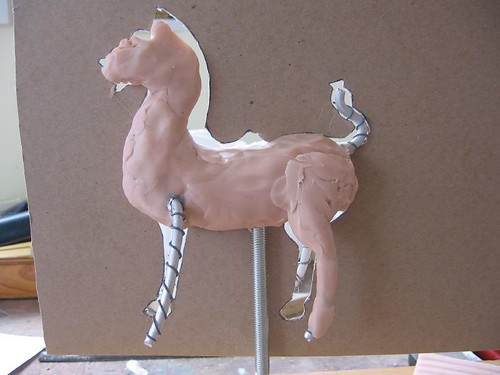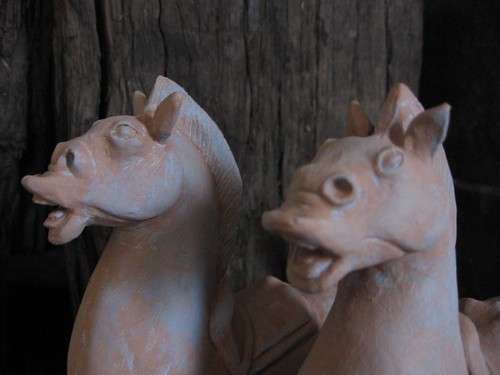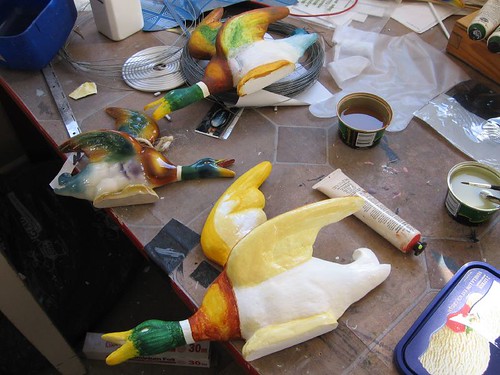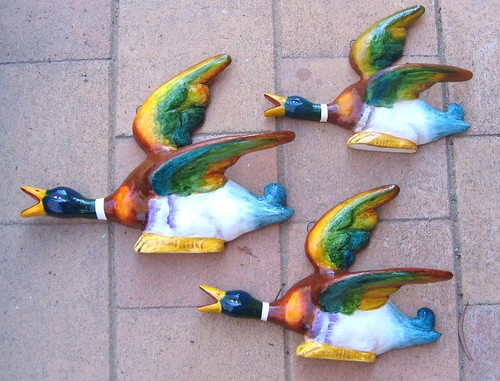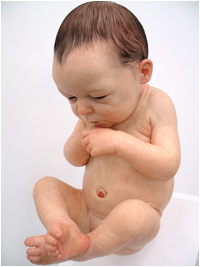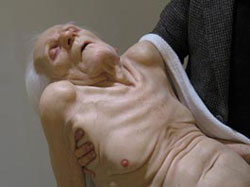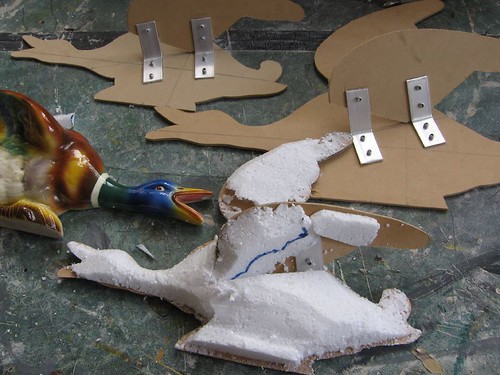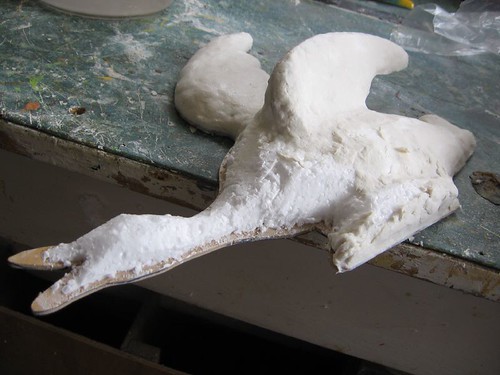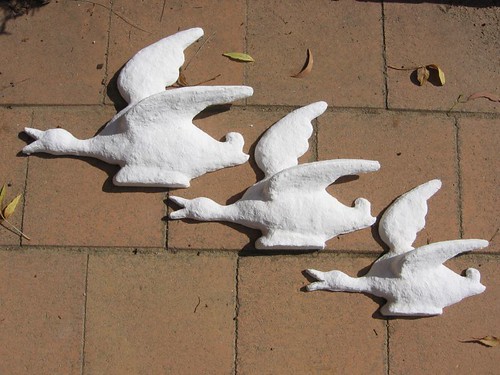Whipped up yesterday from materials at hand, as a surprise for my eldest’s jungle party.
make
All the wild little horses
I loved making these two little horses recently for an up-coming theatre production, Emma’s Dynasty, by Jigsaw Theatre Company. They are based on an earthenware Chinese Han Dynasty horse that is here in the Australian National Gallery collection, but they are tiny in comparison, only 17 cm high at the head. I really like how stocky and wild the horse is, and how he looks like he has come to a screaming halt.
A while ago Andrew at PuppetVision linked to a super sculpey sculpting tutorial by Peter Konig, and it was really useful to me while I was doing the horses – thanks to you both! The tutorial is much more detailed than what I am going to write here – no sense repeating – and I can really recommend it.
The first steps were to make an armature using armature wire. In this case the strength the armature gives the legs and tail is particularly important. From the nose to the tail is one wire, and then the legs are separate wires, wired on with fine wire (Peter has close-ups on how to attach them), and set in place with Knead-It, a Selley’s two-part epoxy. You knead the parts together, and it sets as hard as a rock in five minutes – invaluable stuff!
I also used wire and Knead-It to attach the armature to a firm stand. I struggle with being too impatient at the beginning of a project to go to the trouble of making a firm base like this, and I often regret it – and know I’m going to regret it, what’s more! However, I’m getting wiser about this, and decided to follow Peter’s advice, even though the horse was small.
Another tip that I appreciated was to make a cardboard cutout of the silhouette of the horse to use as a reference while sculpting. I usually sculpt by eye, but this allows you to check how you are going.
I padded out some of the bulkier parts of the body with aluminium foil, as a way of saving how much super sculpey I needed to use later. Wire is wound around the armature wires to give something for the modeling clay to grip onto.
Now the best bit, the modeling! I’ve only recently started using Super Sculpey, and its a real pleasure to work with, because it remains soft for a long time and takes detail so well. Peter says to check it’s soft when you buy it, in case its been on the shelf a long time, and to keep it in a zip lock plastic bag.
So she kneaded it and punched it and pounded and pulled till it looked okay… You can use mineral turpentine to gently bush the surface detail to smooth it, and almost model the tiny detail with the brush.
Into the oven to bake. I had trouble fitting it in my oven still attached to the stand, and ended up putting it in on its side. I thought trying to cut off the support before the horse was baked might risk the horse getting squashed. Maybe next time I should make it so it unscrews instead.
Sawing the support bolt off was a little tricky, but manageable. There were a few small cracks, but I gather this is quite common, and took Peter’s advice to fill them with sculpey and blast it for a few seconds with a heat gun, only in my case it was with a hair dryer. Instant glue is effective for mending breaks. Then, on to the second horse.
Super sculpey takes acrylic paint very well, and I used a dappled mix of greys and terracottas to get the final finish.
There are more photos here. I guess I got a bit carried away, but sometimes that just happens.
Flying ducks again
The ducks have progressed to the painting stage, and I should finish them today. When the paper mache dried fully, it somehow warped the necks and top wings slightly, so that the ducks didn’t sit flat against the wall, so I had to do a bit of surgery, making a cut in each tension point, and filling it to push the part back. I also spent quite a lot of time smoothing the surface and sanding and filing the feather shapes, as the paper mache doesn’t allow fine shaping, and dries just a little bumpy. It’s also proving tricky to get the glazed translucent look that the ceramic ducks have. I am putting a lot of hope in the final varnish!
Update:
This is how they turned out. They are for “1 in A 100”, a play about mental illness (synopsis here) written by Mary Rachel Brown, directed by Carol Woodrow, design by Imogen Keen, at Canberra’s Street Theatre in May 2007.
Sam Jinks
I went to the National Portrait Gallery’s recent exhibition Truth and Likeness because it had one of Sam Jinks’ sculptures on display, one of his son as a very new baby. It’s lovely, and wonderfully detailed, but disquieting at the same time, because its larger-than-life scale acts against the usual instinct to coo over a tiny new born. I also felt an implication – something about the eyes – that this little boy, like all babies, was a secret package, a whole strong personality present in there, just waiting to emerge and be discovered by others over time. I liked that.
Sam Jinks is the artist whom Patricia Piccinini collaborated with to make some of her sculptures, such as The Young Family, but his name has been less well known in the past. It’s cool that he is now exhibiting in his own right. An exhibition of his recent work opens at the Boutwell Draper Gallery in Sydney this week, and you can see some work-in-progress making pictures at that link.
From previous exhibitions:
West Space Inc: 2005 photos
Sam Jinks, Distortions: review of his 2005 West Space exhibition
Carnal Knowledge: about Jinks, and how he thinks about his sculptures
J Arts Crew:: Sculpting the body
Flying ducks
I’m working on several projects at once at the moment. One is making a set of those flying ducks that people had as wall ornaments when I was growing up. I’ve been lent a couple to model from, and looking at them up close I can understand their attraction, despite their kitsch reputation. Since the ones I am making are theatre props they only have to look like the real thing. Inside, they have an mdf structure, and I have bulked them out with polystyrene. I like carving styrene, except for the mess.
The next part of the process is covering the shapes with a commercial paper mache pulp. It starts as a dry mix, and when you add it to water it turns into a thick paste, which can be smoothed on and sticks to most surfaces. Here I’m half way through adding the paper mache to the big duck:
The pulp takes a couple of days to dry, but I’m always impatient with things like this, and I have been hurrying it along by putting the ducks in the sun,
and the oven:
I’ll have to add more detail to the shapes, like the eyes, tails and feather patterns, and then its a matter of getting the surface smooth and painting it to look like china.
We have four beautiful white pet Indian Runner ducks, and it was funny to see them charging across the back garden in a line just as I was photograhing these in the kitchen.
The Tale of How
The Tale of How is a beautiful and intreguing animation, a labour of love by three friends calling themselves the Blackheart Gang, who hail from Cape Town, South Africa. It’s the second part of a larger story they envisage, A Dodo Trilogy. Their ‘making of’ video introduces the makers and explains how they went about it.
(via She Dreams in Digital)
Update: Siouxfire has a cool Concise Overview of “The Household”, a series of interviews, production
images, and information on the two follow-ups completing the Dodo
trilogy as well as the following trilogy (the Bear Histories) at Siouxwire. Thanks, Siouxfire!
Trans-substantiation 2
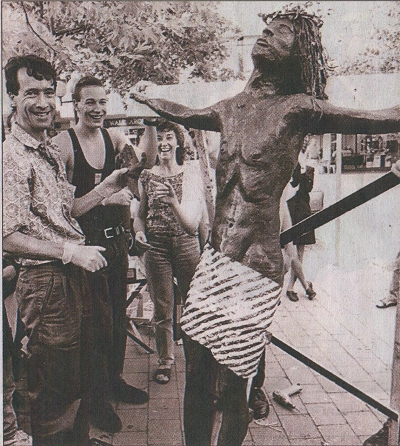
During all the fuss about the chocolate Jesus in the US over the last week or two I kept thinking: ‘Hang on, that was done here years ago!’. Lo and behold, the Canberra Times eventually dredged up their 1994 article on Trans-substantiation 2, by Richard Manderson. With a story beginning with the sale of 100 raspberry-fondant-filled smaller Jesuses at the Gorman House markets, an Easter-egg-foil loin cloth, chocolate-dipped string for hair, a sound artistic statement, a clever title, and the cultural superiority of leading by 13 years, whats not to like?!
Walking with Dinosaurs: The Live Experience: a review
I finally caught up with Walking with Dinosaurs: the Live Experience during its season in Adelaide. The dinosaurs are absolutely fabulous; huge realistic reptiles with fluid movement, thunderous roars, grunts and lowing, and where appropriate, menace. To achieve this live on such a grand scale is impressive, and represents a great pooling of skills in the Creature Design and Build Team: design, engineering, mechanics, skin and sculptural fabrication, technical management and direction. I loved the vegetation that grew up around the arena, and flowered brilliantly; the stage elements that sprouted trees or in turn became volcanoes; and the lighting.
The show is a documentary in the round, or a live newsreel. A paleontologist provides commentary throughout the performance, taking the audience through the various ages of the dinosaurs, pointing out their features, and making the odd joke. Although I saw the need for this as a device to make the show cohesive, and as a way of giving an idea of the sheer size of the creatures, I found it annoying to be ‘educated’ constantly, especially when at times he had to almost shout to be heard over swelling music. Although the dinosaurs threaten each other and have great stand-offs, and at times are wonderfully fierce, the show lacks the emotional content that I think marks great theatre or puppetry; we are instead essentially watching a passing parade of specimens, and observing how they behave.
Perhaps, though, it’s just me, as I am dispassionate about dinosaurs, while the phenomenal popularity of the BBC’s Walking with Dinosaurs documentary series suggests most people are not. The producers picked up on that popularity as the impetus for the live show. They know where their audience is – families, especially those with kids aged about 4 through 12 – and everyone coming out of the stadium seemed happy. I imagine it will continue its success overseas, and I believe there is a second round of dinosaurs now going into production.
More links:
891 ABC Adelaide: Walking with Dinosaurs: Some details and pics about how they are operated :)
SMH: walk among the giants, but hold tight!: Short interview with the puppetry director, Mat McCoy. (cool to see your move to direction, Mat)
‘Making of’ pages from the program: 1, 2
Babushka’s WwD Flickr photoset: some backstage close-up photography
Hangingpixel’s WwD Flickr photoset
YouTube WwD videos
The Age video report: behind the scenes glimpses; Angela Dufty, one of the drivers, explains how they are controlled. (try IE if it won’t play on Firefox)
Previously:
Walking with Dinosaurs: the Live Experience: new slideshow
Workshop footage,
Walking with Dinosaurs: The Live Experience
FantiSea: Giant sea creatures in Esperance
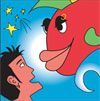 (Cool festival image by Haylie Michelle)
(Cool festival image by Haylie Michelle)
Over in Western Australia, designer and maker Bryan Woltjen and animateur Karen Hethey have been engaged for the last few months on the huge task of designing and building 8 giant puppet sea creatures for FantiSea, which will be held on 22 March as part of the Esperance Festival of the Wind. The festival was at first an art-themed celebration of the positive energy wind brings to the town, and has now evolved into a celebration of ‘community, art, culture and shared fun’.
The building of the giant marine puppets is one of those great projects in which the participation of number of community groups, schools and individuals is integral. The festival’s Workshop Gallery has photos that were taken during the first phase of the build at the end of last year, when the ‘unskinned‘ puppets were built, and some of them were used in the inaugural Christmas pageant in Esperance. You can see how the frameworks are made from a mixture of bamboo and cane, with wire and gaffa joins. I love this picture of the unskinned eel! I would really like to be involved with making puppets of this sort sometime…
More recently during the second phase, the puppets have been skinned with muslin, dipped in diluted PVA, and dyed. Also, Karen Hethy is now teaching performers how to animate the giant puppets and doing stage rehearsals in conjunction with local scriptwriter, Derek Clarke.
Lurk, the shark:
Lighting up Ziggy, the leafy sea dragon:
The gorgeous Dame Agatha, octopus:
The crab (love this one!):
The workshop shed full of finished puppets:
You can click the photos to see them enlarged, and there are more photos here. I think they are wonderful! Thanks, Bryan, for sending me the photos and telling about it all, and I hope to be adding more photos of the actual event.
Update: Photos from the event have now been added.



